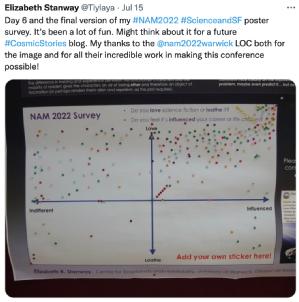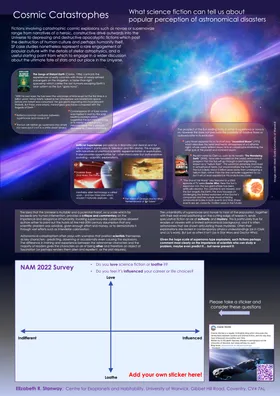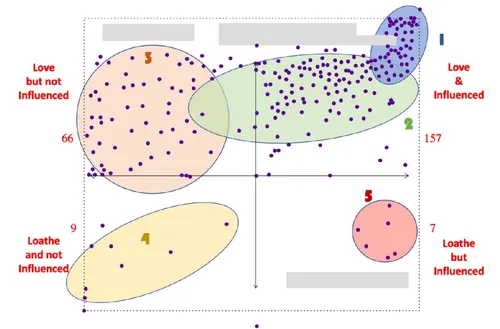Astronomerology
The engagement of physical scientists with science fiction is well known. A number of popular science fiction writers over the years have had training in physics or astronomy. Anecdotal evidence of individual scientists inspired in their career choices by fiction has also been around since science fiction first emerged as a genre, however substantial studies into this phenomenon amongst professional astronomers have been limited.
 In July 2022, I made an impromptu snapshot survey of science fiction enthusiasm amongst my academic peers, taken at the UK National Astronomy Meeting (NAM 2022). This survey was shared on Twitter in the form of the adjacent image, to the interest and amusement of colleagues, and I recently posted a formal write up of the results as a paper on arXiv. Here I thought it might be fun to discuss the survey a little less formally for the blog that inspired it, in order to provide the evidence for future discussions.
In July 2022, I made an impromptu snapshot survey of science fiction enthusiasm amongst my academic peers, taken at the UK National Astronomy Meeting (NAM 2022). This survey was shared on Twitter in the form of the adjacent image, to the interest and amusement of colleagues, and I recently posted a formal write up of the results as a paper on arXiv. Here I thought it might be fun to discuss the survey a little less formally for the blog that inspired it, in order to provide the evidence for future discussions.
The National Astronomy Meeting is a relatively large conference, aimed at gathering together as many members as possible of the UK astronomy, solar and space physics communities, under the auspices of the Royal Astronomical Society. Historically, it has been focussed on relatively junior members of the community, with strong participation by PhD students and postdoctoral researchers, but with presentations from astronomers at all career stages.
This year’s meeting was hosted by the University of Warwick as a hybrid of both online and physical participation, making it the first in-person NAM (and for many the first in-person conference!) for three years, following a cancelled meeting in 2020, and an online-only event in 2021 due to the pandemic. As usual, one element of the science programme was a display of A0-format (i.e. 89x119cm) scientific posters contributed by attendees. These were exhibited for the entire week, between a Sunday evening reception and Friday afternoon, in the same exhibition hall space used for serving refreshments and lunches.

As one of my contributions to this conference [1], I prepared and presented a poster largely based on one of my earlier Cosmic Stories blog entries: “Cosmic Catastrophes: what science fiction can tell us about popular perceptions of astronomical disasters”. Two thirds of the poster presented the scientific content. The remaining third was occupied by a box inviting audience participation in answering two questions:
- “Do you love science fiction or loathe it?”
- “Do you feel it’s influenced your career or life choices?”
Answers were invited in the form of stickers to be placed in a two dimensional parameter space defined by qualitative axes which varied from ‘loathe’ to ‘love’ in one direction and from ‘indifferent’ to ‘influenced’ in the other.
By the end of the meeting, 239 separate responses had been recorded (constituting more than a third of the 637 in-person registrants [2]). By construct, this was an entirely anonymous and unsupervised survey, providing a snapshot of the level of engagement in science fiction within the UK astronomical community.
Perhaps unsurprisingly, images of the poster survey shared on Twitter attracted comment. One suggested that the study of astronomers ought to be termed astronomyonomy (@Alan_Taylor_314), although technically astronomerology would probably be more accurate (hence the name of this blog post!). Other tweets labelled various features in the distribution of points, following a long-established astronomy tradition of making analogies to the distribution of stars on the influential Hertzsprung-Russell diagram used for stellar classification.
One possible schematic grouping is shown in the diagram here, with five regions marked (loosely following the suggestion of @astro_jje on Twitter):
1) The Asymptotic SF Lovers Branch
2) The Astronomers Main Sequence
3) The Weakly Interacting Cloud
4) The SFH (Science Fiction Haters) cooling track
5) The "D" clump
[NB: Digitised values for the points can be found in this file, where values of +/-1 indicates the extrema of axes. The numerically-inclined can also see one-dimensional histograms here and here.]
A clear majority of astronomers consider themselves both to love science fiction and to be influenced by it to a range of degrees, defining a “main sequence”. At the extreme of this, votes maximising both the love and influence expressed while remaining within the constraints of the survey box form an “asymptotic branch”. A sizeable subset of astronomers are science fiction lovers, but do not identify as having been influenced by the genre (a “weakly interacting cloud”), and a few outliers form interesting “clumps”.
Of 239 responses, only 16 (7%) expressed significant dislike of science fiction - one of them going so far as to place a point at the extreme extension of the “loathe” axis possible while remaining on the poster. Another 10 responses were consistent with neutrality between like and dislike. While this fraction of science-fiction dislikers is small, it’s worth noting that it will still constitute between a few individuals in a typical astronomy group, who could easily feel alienated and isolated if a general liking for SF was presumed. Perhaps unsurprisingly the majority of these suggested that science fiction had not influenced them to any significant degree, with a weak trend towards diminishing influence with stronger loathing. However an interesting cluster of 6 individuals (dubbed the "D" clump above) identified as having been strongly influenced by science fiction while expressing a significant dislike for it.
Twitter commentators identified these as “when u hate scifi so much you vow to destroy it from inside the ranks” (@Astrocress) and “devoting their careers to learning how to find and beat up intelligent life” (@NZNeep) [3]. Perhaps a more charitable interpretation might be that frustration with science fiction representations led such people to investigate science in reality, or that an initially positive SF influence has since turned into a strong dislike as they’ve learnt more of the underlying physics. Further surveying would be required to investigate the career choices of this group further - although since they only represent a couple of percent of the population, such a survey would necessarily be large.
The “weakly interacting cloud” constitutes 27% of responses to the survey (66/239). On average these are more likely to express a mild liking rather than strong passion for the subject. These, then, are the casual science fiction consumers, who do not connect their life choices with their viewing or reading preferences.
However a large majority of individual astronomers surveyed (66%, 157/239) chose to place their response in the upper quadrant of the survey, with many clustering around, or lying beyond, “love” as marked on the qualitative axis scale. The existence of the asymptotic branch (reaching extreme values of “love” while at the limits of “influenced”) highlights the strength of feeling amongst those who feel both passionate about science fiction and strongly influenced by it - many respondents made the effort to place their response in the most extreme position available given text and the survey box area. Given the size of this survey sample, there is clear evidence for inspiration from science fiction affecting the career choices of a significant fraction of professional astrophysicists.
The survey presented here is not without flaws:
- No demographic information regarding participants or narrative responses were recorded.
- Axes presented were deliberately qualitative and invited free interpretation, and so some of the structure seen in the distribution of points was shaped by the layout of words and box shape on the poster and may not be intrinsic.
- There is no way of assessing the reasons for non-participation.
- There was also no compelling reason for participants to take the survey seriously and give an honest answer (although nor was there reason to give a false one).
The reasons for non-participation are perhaps the most concerning aspect of any statistical sampling analysis. If disengagement with the poster survey reflects disengagement with science fiction as a genre, then the statistics quoted here will be unrepresentative. However given that this poster was only one of ~180 present in the poster hall (with another 40 online), the large fraction of one- or two-day attendees who prioritised science interaction over poster-reading, the busy conference schedule and the desire of many conference attendees to avoid lingering in the crowded hall given the ongoing pandemic, it is perhaps more likely that many attendees remained unaware of the poster entirely. As a result, the statistics presented here are likely at least somewhat robust.
Despite these limitations, on the face of it, the survey result isn’t a surprise, aligning with some influential stereotypes of physicists and astronomers as ‘nerds’, the common use of science fiction references in astronomical software, and notable examples of astronomy-engaged science fiction writers (including Patrick Moore, Arthur C Clarke, Alistair Reynolds etc) and science-fiction-fan space scientists (including Stephen Hawking, John Zarnecki, Colin Pillinger and others). A while back, during the 2021 lockdown, I actually investigated the statistics of science fiction fandom amongst astronomers with a small survey of the Warwick Astronomy and Astrophysics group and was unsurprised to see a strong interest in science fiction amongst my colleagues - 29/36 (80%) considered themselves a fan of or influenced by science fiction. However, the remaining respondents in that smaller sample questioned the extent to which science fiction had actually influenced them, and others entirely disliked science fiction, prompting my efforts to undertake this simpler but much larger survey.
To the best of my knowledge, there has not hitherto been a large, statistically robust survey to assess whether these anecdotal examples are indeed representative of the current professional astronomy community. In fact, as it turns out, the UK community on average appears to have an even stronger liking for science fiction than my immediate colleagues at Warwick. It'll be fun to extend this kind of survey in future and take similar posters to other national astronomy meetings (with the help of locals) or to open days or science conferences in other fields in order to reach wider audiences. As this survey confirms, the visions of possibility in science fiction, the new horizons and the potential impact of human imagination and creativity, remain powerful motivators of scientists both of the present and of the future.
“Astronomerology”, Elizabeth Stanway. Cosmic Stories blog. 20th August 2022
Notes:
[1] As chair of the Scientific Organising Committee, I had a certain amount of privilege to award myself two posters on topics of cultural astronomy: the science of science fiction entry and a second discussing the history of astronomical inquiry in the city of Coventry. [Return to text]
[2] Note that theoretically the poster was also accessible to catering, cleaning and other conference venue support staff, although they were unlikely to interact with the conference content or contribute to this survey. [Return to text]
[3] Hence "D" for "destroyers"! [Return to text]

